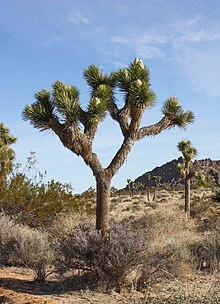Yucca brevifolia
| Joshua tree | |
|---|---|
 |
|
| In Joshua Tree National Park, California | |
| Scientific classification | |
| Kingdom: | Plantae |
| Clade: | Angiosperms |
| Clade: | Monocots |
| Order: | Asparagales |
| Family: | Asparagaceae |
| Subfamily: | Agavoideae |
| Genus: | Yucca |
| Species: | Y. brevifolia |
| Binomial name | |
|
Yucca brevifolia Engelm. |
|
 |
|
| Natural range | |
| Synonyms | |
|
|
Yucca brevifolia is a plant species belonging to the genus Yucca. It is tree-like in habit, which is reflected in its common names: Joshua tree, yucca palm, tree yucca, and palm tree yucca.
The name Joshua tree was given by a group of Mormon settlers crossing the Mojave Desert in the mid-19th century. The tree's unique shape reminded them of a Biblical story in which Joshua reaches his hands up to the sky in prayer. Ranchers and miners who were contemporary with the Mormon immigrants used the trunks and branches as fencing and for fuel for ore-processing steam engines. It is also called izote de desierto (Spanish, "desert dagger"). It was first formally described in the botanical literature as Yucca brevifolia by George Engelmann in 1871 as part of the Geological Exploration of the 100th meridian or Wheeler Survey.
In addition to the autonymic subspecies Yucca brevifolia subsp. brevifolia, two other subspecies have been described:Yucca brevifolia subsp. jaegeriana (the Jaeger Joshua tree or Jaeger's Joshua tree or pygmae yucca) and Yucca brevifolia subsp. herbertii (Webber's yucca or Herbert Joshua tree), though both are sometimes treated as varieties or forms.
Joshua trees are fast growers for the desert; new seedlings may grow at an average rate of 7.6 cm (3.0 in) per year in their first ten years, then only about 3.8 cm (1.5 in) per year. The trunk consists of thousands of small fibers and lacks annual growth rings, making it difficult to determine the tree's age. This tree has a top-heavy branch system, but also what has been described as a "deep and extensive" root system, with roots reaching up to 11 m (36 ft). If it survives the rigors of the desert, it can live for hundreds of years; some specimens survive a thousand years. The tallest trees reach about 15 m (49 ft). New plants can grow from seed, but in some populations, new stems grow from underground rhizomes that spread out around the parent tree.
The evergreen leaves are dark green, linear, bayonet-shaped, 15–35 cm long and 7–15 mm broad at the base, tapering to a sharp point; they are borne in a dense spiral arrangement at the apex of the stems. The leaf margins are white and serrate.
...
Wikipedia
